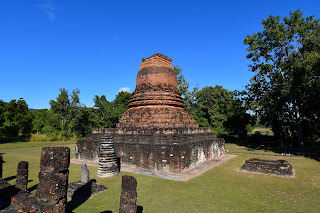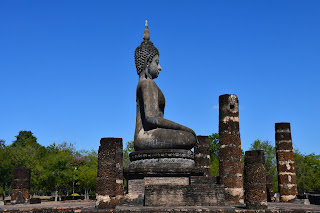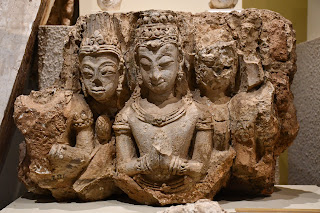Cycling around Sukhothai
I woke up at half past six thinking I would catch a taxi to the bus station and travel to Si Satchanalai. Once I finished my breakfast and opened my phone, however, neither of my mobile apps could find any drivers in the area. For a while, I waited by the side of the road hoping that a taxi or tuk-tuk might go by, but to no avail. After a few minutes, I figured I should stop wasting my time and come up with a proper plan to get myself to Si Satchanalai the next day. In the meantime, I would spend the day exploring Sukhothai. Walking down the road, I soon came across a bike rental place, where I borrowed a creaky bicycle for a hundred baht. Although I would go on to physically exhaust myself, I was very happy I had decided not to walk: the distances between the different sites were considerable and there were often no tuk-tuk drivers waiting to pick up tourists at the more distant attractions.
Empowered
by my acquisition of a bicycle, I let my whims carry me from one place to
another. Sukhothai is split into three ticketed areas: the central area around
Wat Mahathat, the north, and the west (the latter two being outside the old
city walls). There are some sites to the south and east as well, but these do
not require tickets. I started the day with a quick stop by Wat Mahathat to look
across the walls at the sitting and standing stucco Buddhas. I then cycled
north outside of the city walls to visit the famous seated Buddha of Wat Si
Chum and the single prang of Wat Phrapai Luang.
Since I had
a lot of energy, I figured I would cycle to the western area as well, climbing
up to the standing Buddha of Wat Saphan Hin and stopping by the stupa of Wat
Mangkorn. Just a short ride south of the stupa, I visited the Saritphong Dam,
which offers nice views of the hills in the west rising above the surface of
the Sao Ho. Completing this journey around the periphery, I cycled across to
the southern cluster, whose most recognisable structures are the standing
Buddha of Wat Chetuphon and the elephant-lined stupa of Wat Chedi Si Hong.
During this
portion of the ride, the pleasantly cool forests gave way to open fields. Some
of them appeared to be rice fields and had cows walking across them slowly with
white egrets in tow. Many fields, however, were full of tall sugar cane stalks.
Everywhere was teeming with life: there were stumpy brown herons resting on the
sides of the ditches, kingfishers perching on electric lines, and black birds
with long cleft tails flitting back and forth between the forests. Some of the
trees by the roadside were so full of herons and egrets that the ground below
them had turned completely white with bird excrement, and I had to hold my
breath to ride across it.
I returned
to the central area by eleven o’clock, starting with the three prangs of Wat Si
Sawai and then walking around Wat Mahathat. By the time I had also seen the
stupas of Wat Sa Si and Wat Sorasak (the latter of which has beautifully
preserved elephant statues along its base), I felt hungry, so I stopped by a
nearby restaurant to refuel. The meal got me through the rest of the day: first
a quick excursion to the east side to visit the elephant-lined stupa of Wat
Chang Lom, and then through the centre back to Wat Si Chum. I figured I might
as well take another look at it since I had so much time to kill.
My final
stop of the day was the Ramkhamhaeng National Museum, which houses many
artefacts from Sukhothai, as well as Si Satchanalai and faraway places like Si
Thep. Besides its collections, the museum’s most interesting feature is a
recreation of the corridor which leads up and around the giant Buddha of Wat Si
Chum and which is inaccessible to tourists. The exhibition partially recreates
it with miniature versions of the Jatakas depicted on the walls and on the ceiling.
Of course,
I also learned more about the history of Sukhothai. The city was originally
inhabited by the Khmers, who built a few temples that survive to this day, for
example Wat Phrapai Luang and Wat Si Sawai. After brief rule by the Mon Kingdom
of Lavo, the city was conquered by the Thais, who proceeded to establish what
traditionalist historians see as the first Thai kingdom. Under King Ramkamhaeng,
Sukhothai developed its own script, which developed into the script Thailand
uses today. Despite such cultural achievements and the vast territorial extent
of Sukhothai at the peak of its power, its glory days did not last long. After
many of its tributaries shook off its yoke and others were absorbed by neighbouring
kingdoms, Sukhothai was invaded in 1378 by Ayutthaya.












































Comments
Post a Comment